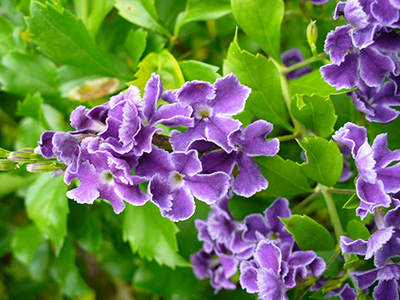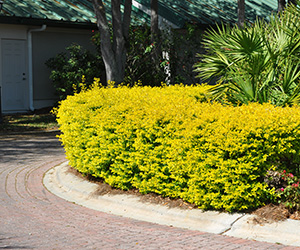Golden Dewdrop

Golden dewdrop (Duranta erecta) is an evergreen shrub or small tree with enticing blue-purple flowers that attract a host of pollinators. Its common name references the showy yellow fruits that cascade from its weeping branches.
Characteristics
Golden dewdrop sports bright yellow-green, oval leaves with serrated margins. Branches are irregular and drooping, particularly when adorned with fountains of flowers and fruits. The shrub grows 10 to 15 feet wide and up to 18 feet tall, depending on growing conditions and pruning frequency. Golden dewdrop often has multiple small trunks.
In addition to bright foliage, this shrub also produces purple, white, or blue flowers in the summer and fall. The blooms are clustered in a form called raceme, arranged along a central axis with the oldest flowers at the base and the youngest at the top. In summer you can also begin to spot their striking golden fruits called drupes. Since the flowers and fruits can be seen simultaneously, the plant can be particularly showy. The fruits are typically half an inch in diameter and hang from the plant like densely clustered grapes.
Fruits can remain on the shrub into the winter, providing a pop of color to a dull landscape. That is, if they’re not removed by wildlife. Birds will happily devour the golden feast provided by the plant. In fact, the alternate common name “pigeon berry” was presumably coined because the fruits are favored by pigeons. The flowers will also attract butterflies, bumble bees and hummingbirds.
There are several cultivars of golden dewdrop. Most commonly seen is ‘Gold Mound’ with golden-yellow leaves and lavender-blue flowers. It has a low-growing form, reaching about 4 feet tall and 5 feet wide. The ornamental ‘Sapphire Shower’ has purple flowers, while ‘Alba’ produces white blossoms. There is also a variegated cultivar called ‘Variegata’ with white- or yellow-edged leaves for added interest.
Planting and Care

Golden dewdrop can be grown in USDA zones 9a through 11b, although temperatures in the low forties can cause leaves to turn a purple hue. Even if it experiences cold damage, golden dewdrop will bounce back in the spring.
The shrub is tolerant of most soil types but cannot survive salt. It will grow in partial shade but prefers full sun. While golden dewdrop prefers moist, well-drained soil, it is drought tolerant once established. This shrub works well as a screen or backdrop plant and creates a nice barrier. This versatile plant can even work as a container plant and can be grown indoors next to a sunny window. If you wish to propagate it, seeds or stem cuttings are the best methods.
And while they may look tantalizing, the fruits (and leaves) are actually poisonous to humans and dogs, so plant with caution. And be sure to wear gloves when pruning or planting; each leaf has a thorn, and the sap can be irritating on the skin.
Pest problems are typically not serious, but potential offenders are caterpillars, nematodes, and scale. Contact your county Extension office for advice if you notice any severe issues.

Golden dewdrop, true to its name, is a dazzling plant with many interesting traits. The clustered flowers and golden fruits not only add intrigue to the landscape, but also attract wildlife. This shrub is perfect for Florida’s sunny climate and could be your next feature plant.
Note: Evidence from 19th century herbarium specimens suggests that golden dewdrop was once native to South Florida. However, the golden dewdrop plant that is widely cultivated and found in the wild today is morphologically distinct from the historical version and is not considered native to Florida.
